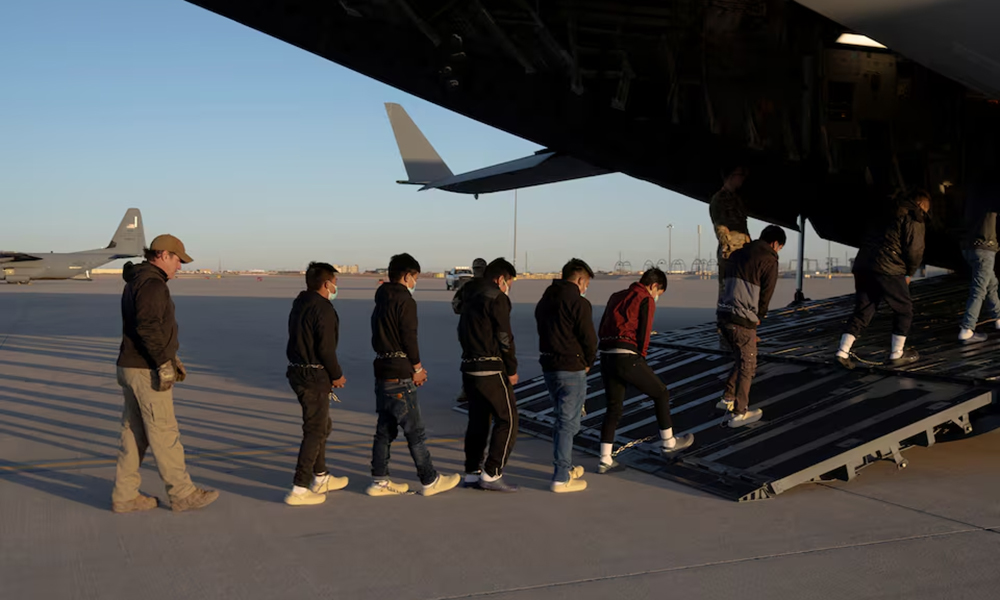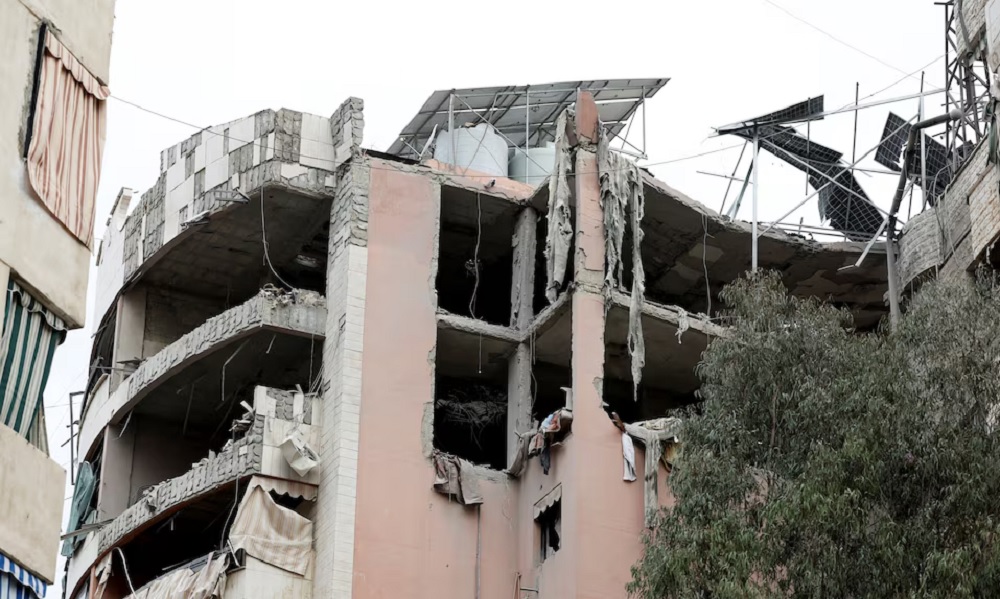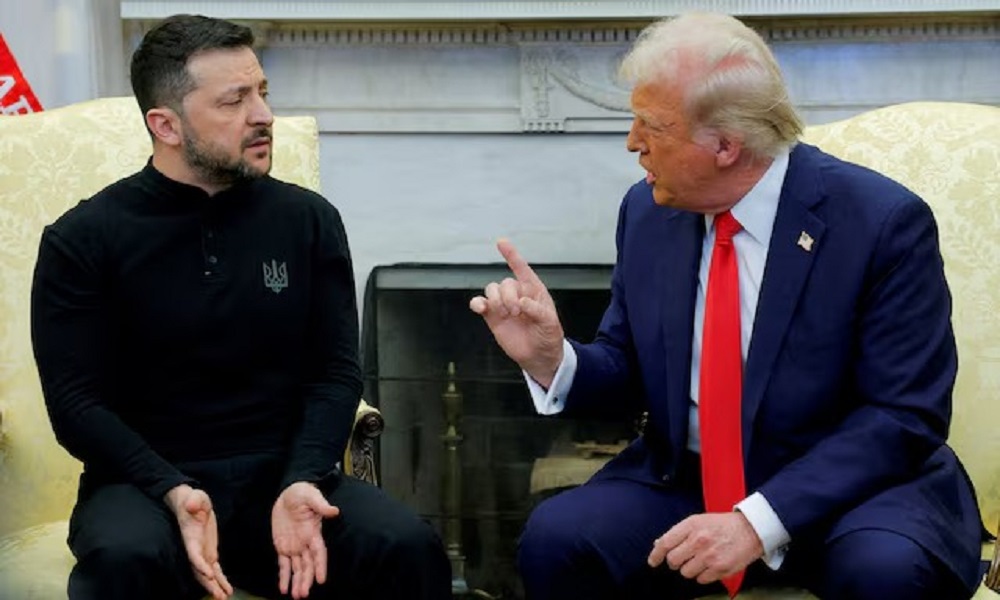World
Trump imposes tariffs, sanctions on Colombia after it refuses deportation flights
U.S. military aircraft carried out two similar flights, each with about 80 migrants, to Guatemala on Friday, Reuters reported.

The U.S. and Colombia lurched toward a trade war on Sunday as President Donald Trump threatened tariffs and sanctions on the country to punish it for turning away military aircraft carrying migrants being deported as part of his immigration crackdown, Reuters reported.
Colombia, the third largest U.S. trading partner in Latin America, swiftly responded, with leftist President Gustavo Petro first threatening a 50% tariff on U.S. goods and later posting on X that he had directed his trade minister to increase tariffs on U.S. imports by 25%.
Colombia is the second Latin American nation to refuse U.S. military deportation flights. Trump’s punitive action demonstrated his more muscular U.S. foreign policy and his renewed willingness to force countries to bend to his will.
Trump wrote on Truth Social that Petro’s refusal to accept the flights jeopardized U.S. national security.
The retaliatory measures include imposing 25% tariffs on all Colombian goods coming into the U.S., which will go up to 50% in one week; a travel ban and visa revocations on Colombian government officials; and emergency treasury, banking and financial sanctions.
Trump said he would also direct enhanced border inspections of Colombian nationals and cargo.
“These measures are just the beginning,” he wrote. “We will not allow the Colombian Government to violate its legal obligations with regard to the acceptance and return of the Criminals they forced into the United States!”
He later posted a picture of himself on Truth Social in a pinstripe suit and a fedora in front of a sign reading FAFO, a common slang acronym for “Fuck Around and Find Out”.
America will “no longer be lied to nor taken advantage of,” U.S. Secretary of State Marco Rubio in a statement, adding that Petro had authorized these flights but then canceled his authorization when the planes were in the air.
A State Department spokesperson said the United States has suspended visa processing at the U.S. embassy in Bogota, read the report.
Trump declared illegal immigration a national emergency and imposed a sweeping crackdown since taking office last Monday. He directed the U.S. military to help with border security, issued a broad ban on asylum and took steps to restrict citizenship for children born on U.S. soil.
Colombia’s Petro condemned the practice on Sunday, suggesting it treated migrants like criminals. In a post on social media platform X, Petro said Colombia would welcome home deported migrants on civilian planes.
He also offered his presidential plane to facilitate the “dignified return” of Colombian nationals.
Petro said even though there were 15,660 Americans without legal immigration status in Colombia, he would never carry out a raid to return handcuffed Americans to the U.S.
“We are the opposite of the Nazis,” he wrote.
Mexico also refused a request last week to let a U.S. military aircraft land with migrants.
Trump did not take similar action against Mexico, the largest U.S. trading partner, but has said he is thinking about imposing 25% duties on imports from Canada and Mexico on Feb. 1 to force further action against illegal immigrants and fentanyl flowing into the U.S, Reuters reported.
A White House source said that the situation escalated quickly after Petro changed his mind about accepting the flights, with Trump taking “immediate action.”
“Absolutely. Yes. Countries have an obligation to accept repatriation flights,” the source said when asked if Trump was using Colombia to set an example. “The United States is simply sending back the criminals that Colombia sent to the United States.”
The U.S. is Colombia’s largest trading partner, largely due to a 2006 free trade agreement that generated $33.8 billion in two-way trade in 2023 and a $1.6 billion U.S. trade surplus, according to U.S. Census Bureau data.
But Colombia ranks just 23rd among U.S. trading partners, which means it may have more to lose.
Alejo Czerwonko, chief investment officer for emerging markets Americas at UBS Global Wealth Management, said Colombia relied on access to the U.S. market for about a third of its exports, or about 4% of its GDP.
“In addition, the Petro-Trump relationship has started off on the wrong foot, which could signal additional challenges ahead,” Czerwonko told Reuters.
Colombia’s top 2023 exports to the U.S. were heavy crude oil, gold, coffee, cut roses, aluminum windows and diesel fuel, Census Bureau data showed. Its top imports from the U.S. were gasoline, civilian aircraft, corn, naphthas, and soybean solids.
Petro’s comments added to the growing chorus of discontent in Latin America as Trump’s week-old administration starts mobilizing for mass deportations.
Brazil’s foreign ministry on Saturday condemned “degrading treatment” of Brazilians after migrants were handcuffed on a commercial deportation flight. Upon arrival, some passengers also reported mistreatment during the flight, according to local news reports.
The plane, which was carrying 88 Brazilian passengers, 16 U.S. security agents, and eight crew members, had been originally scheduled to arrive in Belo Horizonte in the southeastern state of Minas Gerais.
However, at an unscheduled stop due to technical problems in Manaus, capital of Amazonas, Brazilian officials ordered removal of the handcuffs, and President Luiz Inácio Lula da Silva designated a Brazilian Air Force (FAB) flight to complete their journey, the government said in a statement on Saturday.
The commercial charter flight was the second this year from the U.S. carrying undocumented migrants deported back to Brazil and the first since Trump’s inauguration, according to Brazil’s federal police.
U.S. officials did not reply to requests for comment about Brazil.
The use of U.S. military aircraft to carry out deportation flights is part of the Pentagon’s response to Trump’s national emergency declaration on immigration on Monday.
In the past, U.S. military aircraft have been used to relocate individuals from one country to another, like during the U.S. withdrawal from Afghanistan in 2021.
This has been the first time in recent memory that U.S. military aircraft were used to fly migrants out of the country, one U.S. official said.
U.S. military aircraft carried out two similar flights, each with about 80 migrants, to Guatemala on Friday, Reuters reported.
World
As Iran tensions build, US military moves warplanes to reinforce Middle East
U.S. President Donald Trump threatened Iran on Sunday with bombing and secondary tariffs if Tehran did not come to an agreement with Washington over its nuclear program.

U.S. Defense Secretary Pete Hegseth has reinforced U.S. military capability in the Middle East with more warplanes, the Pentagon said on Tuesday, amid a more than two-week-old U.S. bombing campaign in Yemen and mounting tensions with Iran, Reuters reported.
The Pentagon’s brief statement did not specify which aircraft were being deployed or where precisely they were sent.
However, as many as six B-2 bombers have relocated in the past week or so to a U.S.-British military base on the Indian Ocean island of Diego Garcia, according to U.S. officials, speaking on condition of anonymity.
Experts say that puts the B-2s, which have stealth technology and are equipped to carry the heaviest U.S. bombs and nuclear weapons, in an ideal position to operate in the Middle East.
“Should Iran or its proxies threaten American personnel and interests in the region, the United States will take decisive action to defend our people,” Pentagon spokesperson Sean Parnell said in a statement.
The U.S. military’s Strategic Command has declined to say how many B-2s have reached Diego Garcia and noted that it does not comment on exercises or operations involving the B-2.
There is already considerable firepower in the Middle East and the U.S. military will soon have two aircraft carriers in the region, read the report.
U.S. President Donald Trump threatened Iran on Sunday with bombing and secondary tariffs if Tehran did not come to an agreement with Washington over its nuclear program.
While B-2 bombers have been employed to strike buried Houthi targets in Yemen, most experts say use of the stealthy bomber is overkill there and the targets aren’t buried so deeply.
However, the B-2 is equipped to carry America’s most potent bomb — the 30,000-pound GBU-57 Massive Ordnance Penetrator. That is the weapon that experts say could be used to strike Iran’s nuclear program.
There are only 20 B-2 bombers in the Air Force’s inventory so they are usually used sparingly.
Iran’s Supreme Leader Ayatollah Ali Khamenei said on Monday the U.S. would receive a strong blow if Trump followed through with his threats.
Revolutionary Guards Aerospace Commander Amirali Hajizadeh threatened U.S. forces in the Middle East, noting American bases in the Middle East and adding: “They are in a glass house and should not throw stones.”
One official told Reuters that the U.S. military was also moving some air defense capabilities from Asia to the Middle East.
In his 2017-2021 term, Trump withdrew the U.S. from a 2015 deal between Iran and world powers that placed strict limits on Tehran’s disputed nuclear activities in exchange for sanctions relief. Trump also reimposed sweeping U.S. sanctions.
Since then, Iran has far surpassed that deal’s limits on uranium enrichment.
Western powers accuse Iran of having a clandestine agenda to develop nuclear weapons capability by enriching uranium to a high level of fissile purity, above what they say is justifiable for a civilian atomic energy program. Tehran says its nuclear program is wholly for civilian energy purposes.
World
Israel kills Hezbollah official in deadly Beirut airstrike

An Israeli airstrike killed four people including a Hezbollah official in Beirut’s southern suburbs on Tuesday, a Lebanese security source said, further testing a shaky ceasefire between Israel and Iran-backed Hezbollah.
The Israeli military said the official – Hassan Bdeir – was a member of a Hezbollah unit and Iran’s Quds Force, and he had assisted the Palestinian group Hamas in planning a “significant and imminent terror attack against Israeli civilians,” Reuters reported.
The Lebanese security source said the target was a Hezbollah figure whose responsibilities included the Palestinian file. The Lebanese health ministry said the strike killed four people – including a woman – and wounded seven others.
It marked Israel’s second airstrike in the Hezbollah-controlled suburb of Beirut in five days, adding to strains on the U.S.-brokered ceasefire that ended last year’s devastating conflict.
The attacks on Beirut’s southern suburbs have resumed at a time of broader escalation in the region, with Israel having restarted Gaza strikes after a two-month truce and the United States hitting the Iran-aligned Houthis of Yemen in a bid to get them to stop attacking Red Sea shipping.
Hezbollah lawmaker Ibrahim Moussawi said the Israeli attack amounted to “a major and severe aggression that has escalated the situation to an entirely different level”.
Speaking in a televised statement after visiting the building that was struck, he called on the Lebanese state to “activate the highest level of diplomacy to find solutions”.
Israeli Foreign Minister Gideon Saar said the eliminated Hezbollah operative posed “a real and immediate threat”. “We expect Lebanon to take action to uproot terrorist organizations acting within its borders against Israel,” he said.
Israel dealt severe blows to Hezbollah in the war, killing thousands of its fighters, destroying much of it arsenal and eliminating its top leadership including Hassan Nasrallah.
Hezbollah has denied any role in recent rocket attacks from Lebanon towards Israel, including one that prompted Israel to carry out an airstrike on the southern suburbs last Friday.
Tuesday’s strike in the early hours appeared to have damaged the upper three floors of a building, a Reuters reporter at the scene said, with the balconies of those floors blown out.
The glass on the floors below was intact, indicating a targeted strike. Ambulances were at the scene as families fled to other parts of Beirut.
There was no advance warning, in contrast to the attack on Friday when the Israeli military announced which building it intended to hit and ordered residents to leave the area.
Lebanese President Joseph Aoun condemned the latest airstrike, calling it a “dangerous warning” that signals premeditated intentions against Lebanon, which would intensify diplomatic outreach and mobilise international allies.
Lebanese Prime Minister Nawaf Salam said the strike was a flagrant breach of a U.N. Security Council Resolution upon which the ceasefire was based, and the ceasefire arrangement.
U.S. BACKS ISRAEL
The ceasefire agreement demanded that southern Lebanon be free of Hezbollah fighters and weapons, that Lebanese troops deploy into the area, and that Israeli troops withdraw.
But each side accuses the other of failing to implement the terms fully. Israel says Hezbollah still has infrastructure in the south, while Lebanon and Hezbollah say Israel is occupying Lebanese soil by not withdrawing from five hilltop positions.
The U.S. State Department said that Israel was defending itself from rocket attacks that came from Lebanon and that Washington blamed “terrorists” for the resumption of hostilities.
“Hostilities have resumed because terrorists launched rockets into Israel from Lebanon,” a State Department spokesperson said in an email, responding to a question from Reuters seeking reaction to Tuesday’s airstrike. Washington supported Israel’s response, the spokesperson said.
The Israel-Hezbollah conflict was ignited when Hezbollah opened fire in support of Hamas at the start of the Gaza war. It escalated in September when Israel went on the offensive, declaring the aim of securing the return home of tens of thousands of people evacuated from homes in the north.
The war uprooted more than a million people and killed at least 3,768 people in Lebanon, according to a Lebanese health ministry toll from November. Dozens more have been reported killed by Israeli fire since the ceasefire.
Lebanon’s figures do not distinguish between civilians and fighters.
During the war, Hezbollah strikes killed 45 civilians in northern Israel and the Israeli-occupied Golan Heights. At least 73 Israeli soldiers were killed in northern Israel, the Golan Heights, and in combat in southern Lebanon, according to Israeli authorities.
World
Trump says Zelenskiy wants to back out of critical minerals deal

U.S. President Donald Trump said on Sunday Ukrainian President Volodymyr Zelenskiy wants to back out of a critical minerals deal, warning the Ukrainian leader would face big problems if he did.
“He’s trying to back out of the rare earth deal and if he does that he’s got some problems, big, big problems,” Trump told reporters.
“He wants to be a member of NATO, but he’s never going to be a member of NATO. He understands that.”
(Reuters)
-

 Latest News4 days ago
Latest News4 days agoAfghanistan’s reconstruction is in the interest of EU: Uzbek president
-

 Latest News5 days ago
Latest News5 days agoUS won’t rest until all Americans detained in Afghanistan brought home: Rubio
-

 Latest News3 days ago
Latest News3 days agoMinistry of Economy calls on US to release Afghanistan’s frozen funds
-

 Latest News4 days ago
Latest News4 days agoBulgaria brings five people to trial over deaths of 18 Afghan migrants
-

 Latest News3 days ago
Latest News3 days agoPakistan ‘extends’ deadline for a week for Afghans to leave the country
-

 Regional5 days ago
Regional5 days agoChina launches military drills around Taiwan, calls its president a ‘parasite’
-

 Business4 days ago
Business4 days agoGold climbs to record high as tariff worries bolster safe-haven demand
-

 Sport4 days ago
Sport4 days agoIPL 2025: Batters in race for prestigious Orange Cap

























